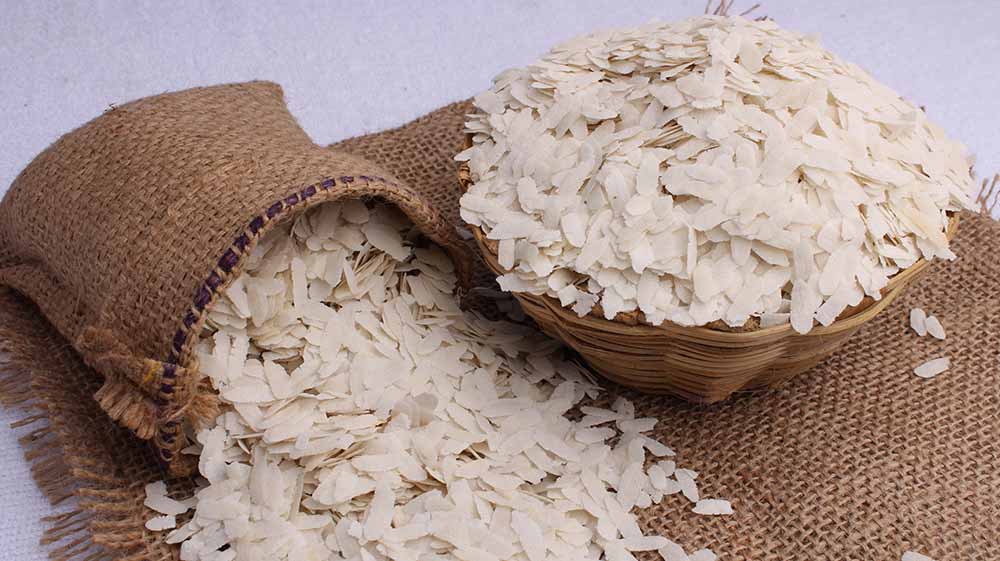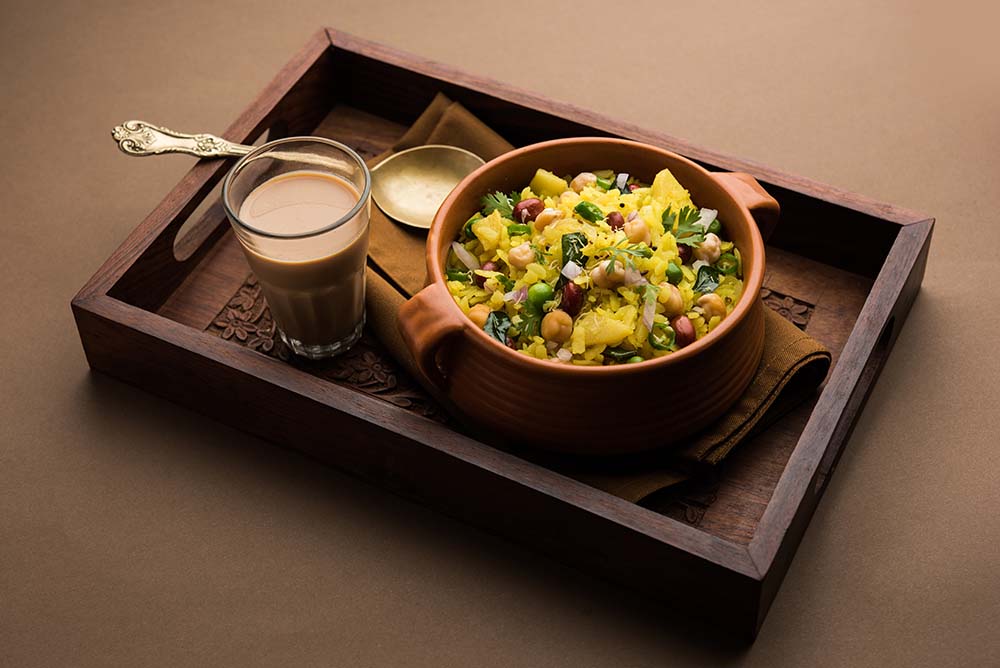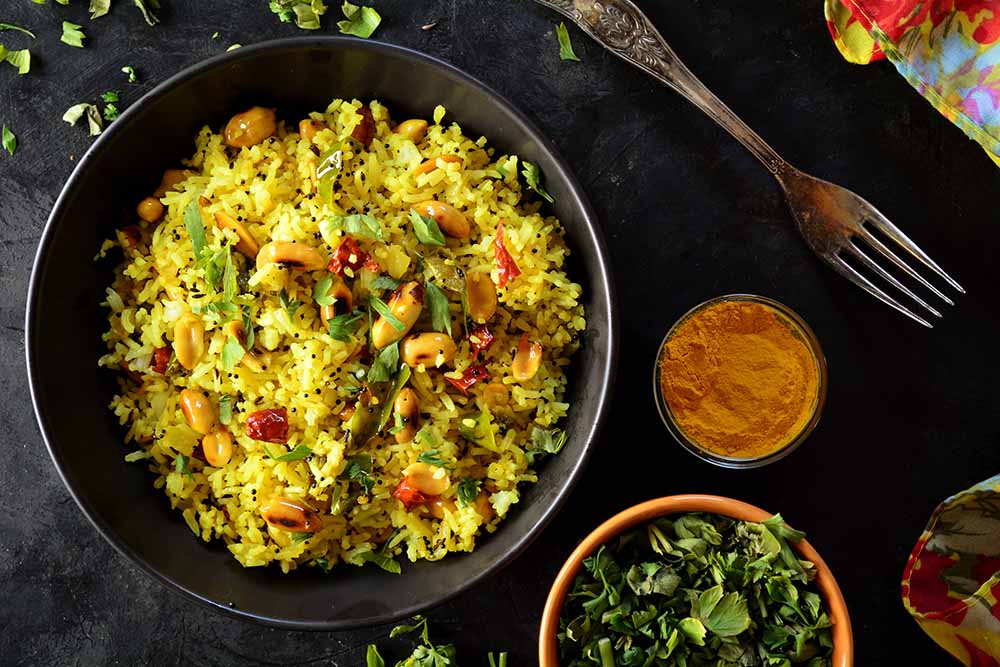Poha, also known as pauwa, sira, chira, or avalakki is flattened rice which is a staple in every household in India. It is a type of rice dish made from raw, toasted, or parboiled rice grains pounded into flat flakes. These flakes come in different thicknesses and have no distinct aroma, and also have a bland taste. Depending on the preparation, they can be soft or crunchy. Poha is known to absorb a lot of liquid and hence takes on a lot of flavour and cooks very quickly.
Health Benefits of Poha

• Rich In Carbohydrates: One cup of poha provides approximately 35 grams of carbohydrates, enough to keep you full and energised for a long morning.
• Helps Maintain Blood Sugar Levels: It is rich in fibre, and helps in preventing any sudden increase in blood sugar levels. It also promotes a slow and stable release of sugar into the blood stream.
• Excellent Source for Iron: The production process of poha requires the rice to pass through iron rollers. This process helps the flattened rice retain some of the iron. Pro tip: Squeeze fresh lemon juice in your bowl of cooked poha to help your body absorb the iron better.
• Good For Gut Health: Poha is a good probiotic food. Flattened rice retains the microbial flora from the partially digested carbs and proteins, which is healthy for the gut. It can also be easily digested and does not cause bloating.
• Perfect To Keep Your Calorie Count In Check: One bowl of cooked poha has less than 250 calories, and is also rich in essential vitamins, minerals and antioxidants.
Preparing The Perfect Poha For Breakfast

Poha is a classic and a preferred breakfast recipe in Western states of India, especially Maharashtra. This breakfast recipe, popularly known as Pohe in Marathi and Poha in Gujarati, uses flattened rice (thick poha) as the main ingredient. It is cooked usually with cubed potatoes, mustard seeds, onions, peanuts and curry leaves. This step-by-step poha recipe makes it extremely easy for anyone to make poha at home.
Preparation Time: 5 minutes
Cooking Time: 20 minutes
Serves: 4-5 servings
Ingredients:
• 4 cups thick poha
• 2 medium onion, finely chopped
• 2 small potatoes, peeled and finely cubed
• 1 teaspoon mustard seeds
• 1 teaspoon cumin seeds
• 15 curry leaves
• 3 green chillies, finely chopped
• 2 tablespoons peanuts
• 1 teaspoon turmeric powder
• 2 teaspoons lemon juice
• 1 tablespoon sugar
• Salt to taste
• 4 tablespoons oil
• 4 tablespoons coriander leaves, finely chopped
Method:
1. Using a large strainer wash the poha twice gently by using your fingers under running water.
2. Drain the extra water.
3. Sprinkle salt and sugar over it. Mix well and keep aside.
4. To a pan, heat oil and add mustard seeds; sauté for a few seconds
5. Add cumin seeds, green chilies, curry leaves, and peanuts.
6. Once the chillies are crispy add the onions and fry until translucent
7. Next add potatoes and a pinch of salt.
8. Cover and cook until the potatoes turn tender.
9. Add turmeric and mix well.
10. Now add the main ingredient poha to the potatoes and the masala.
11. Mix till the poha is completely coated with the masala.
12. Cook for 4-5 minutes and turn off the flame.
13. Squeeze some lemon juice, and top with finely chopped coriander leaves.
14. Mix well and now your Batata poha is ready!
Pro Tips For Getting The Poha Recipe Right Always:

• Never soak poha in water for a long time.
• Always strain out excess water or else your poha will be soggy. The poha should be moist not wet. The easiest way to do this is to place the poha in a colander or large strainer and pour water over it. This way, the poha will be clean and the excess water will also drain out easily.
• If case you do not have a strainer, sprinkle some water over the flakes and let it soak exactly for five minutes. For example, if you are cooking 2 cups poha sprinkle on 3 tablespoons water.
• Always use the thick variation available in stores for making breakfast poha.
• Always adjust sugar, salt and lemon according to your taste buds.
• To add some crunch to your breakfast add sev to your poha.
• You may also use boiled potatoes, and roasted peanuts to fasten the cooking process.
• Poha is great when served with piping hot tea, and even is a great option for school and office lunchbox.
Kanda Pohe is a very simple recipe where softened moist flattened rice is sautéed with a crackling tempering of mustard seeds, cumin seeds, curry leaves, green chilies, and onions. Roasted or fried peanuts and sev are added for crunch and garnished with coriander leaves and lemon juice to ramp up the freshness. You may also add different vegetables like peas, cauliflower and beans to make it a more wholesome lunch option.
Frequently Asked Questions
1. Why is my poha soggy?
Submerging and soaking the poha in water or over-rinsing can turn it soggy, causing it to turn into a mush. You may have also used the thin variety instead of the thick poha.
2. How do I store?
Try and make poha in small batches since it is best eaten fresh. If kept in the fridge it often turns dry, however leftovers can be stored covered in an airtight container in the refrigerator for two days. To consume again, reheat in the microwave or in a pan on the stovetop by sprinkling some water to bring back the moisture.